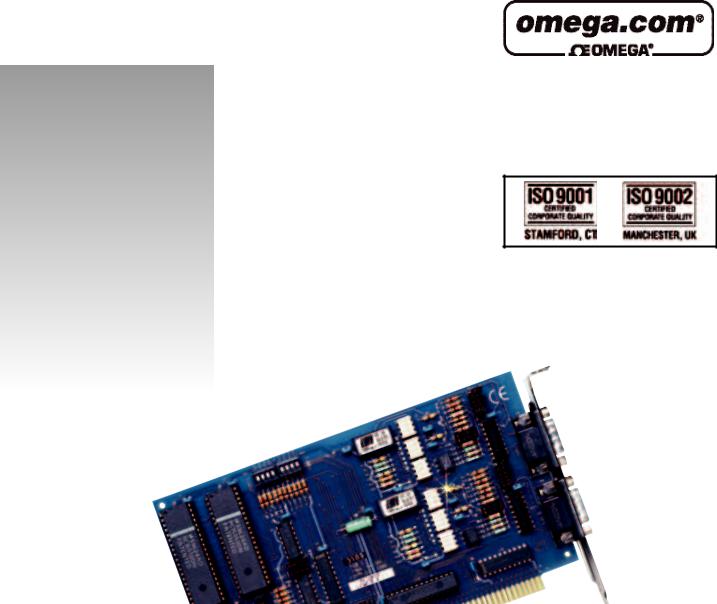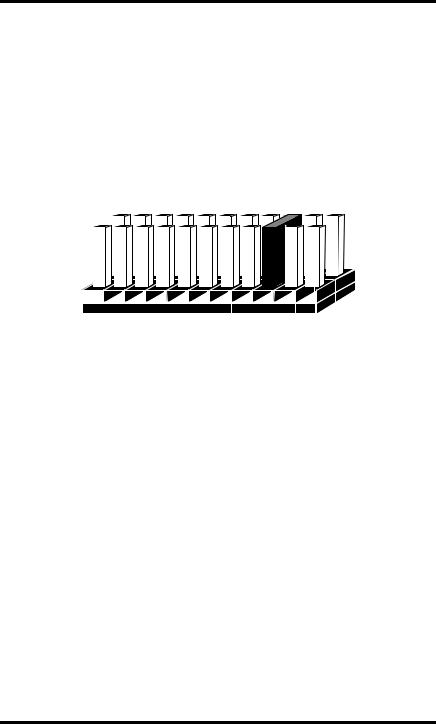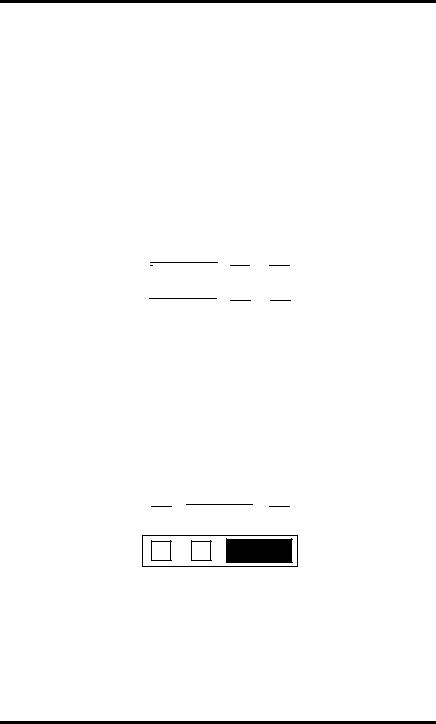Omega RS-422 User Manual

User’sGuide
Shop online at
www.omega.com e-mail: info@omega.com
OMG-ULTRA-SIO
Dual Port Isolated/Non-Isolated
ISA RS-422/485 Adaptor Board

|
OMEGAnet® Online Service |
|
Internet e-mail |
|
|
|
www.omega.com |
|
info@omega.com |
|
|
|
|
|
|
|
Servicing North America: |
||
USA: |
One Omega Drive, P.O. Box 4047 |
|
||
ISO 9001 Certified |
Stamford CT 06907-0047 |
|
||
|
|
TEL: (203) 359-1660 |
FAX: (203) 359-7700 |
|
|
|
e-mail: info@omega.com |
|
|
Canada: |
976 Bergar |
|
||
|
|
Laval (Quebec) H7L 5A1, Canada |
|
|
|
|
TEL: (514) 856-6928 |
FAX: (514) 856-6886 |
|
|
|
e-mail: info@omega.ca |
|
|
For immediate technical or application assistance:
USA and Canada: Sales Service: 1-800-826-6342 / 1-800-TC-OMEGA® Customer Service: 1-800-622-2378 / 1-800-622-BEST® Engineering Service: 1-800-872-9436 / 1-800-USA-WHEN® TELEX: 996404 EASYLINK: 62968934 CABLE: OMEGA
Mexico: |
En Espan˜ol: (001) 203-359-7803 |
e-mail: espanol@omega.com |
|
FAX: (001) 203-359-7807 |
info@omega.com.mx |
Servicing Europe:
Benelux: |
Postbus 8034, 1180 LA Amstelveen, The Netherlands |
|||
|
|
|
TEL: +31 (0)20 3472121 |
FAX: +31 (0)20 6434643 |
|
|
|
Toll Free in Benelux: 0800 0993344 |
|
|
|
|
e-mail: sales@omegaeng.nl |
|
Czech Republic: |
Frystatska 184, 733 01 Karviná, Czech Republic |
|||
|
|
|
TEL: +420 (0)59 6311899 |
FAX: +420 (0)59 6311114 |
|
|
|
Toll Free: 0800-1-66342 |
e-mail: info@omegashop.cz |
France: |
11, rue Jacques Cartier, 78280 Guyancourt, France |
|||
|
|
|
TEL: +33 (0)1 61 37 29 00 |
FAX: +33 (0)1 30 57 54 27 |
|
|
|
Toll Free in France: 0800 466 342 |
|
|
|
|
e-mail: sales@omega.fr |
|
Germany/Austria: |
Daimlerstrasse 26, D-75392 Deckenpfronn, Germany |
|||
|
|
|
TEL: +49 (0)7056 9398-0 |
FAX: +49 (0)7056 9398-29 |
|
|
|
Toll Free in Germany: 0800 639 7678 |
|
|
|
|
e-mail: info@omega.de |
|
United Kingdom: |
One Omega Drive, River Bend Technology Centre |
|||
ISO 9002 Certified |
Northbank, Irlam, Manchester |
|
||
|
|
|
M44 5BD United Kingdom |
|
|
|
|
TEL: +44 (0)161 777 6611 |
FAX: +44 (0)161 777 6622 |
|
|
|
Toll Free in United Kingdom: 0800-488-488 |
|
|
|
|
e-mail: sales@omega.co.uk |
|
It is the policy of OMEGA to comply with all worldwide safety and EMC/EMI regulations that apply. OMEGA is constantly pursuing certification of its products to the European New Approach Directives. OMEGA will add the CE mark to every appropriate device upon certification.
The information contained in this document is believed to be correct, but OMEGA Engineering, Inc. accepts no liability for any errors it contains, and reserves the right to alter specifications without notice.
WARNING: These products are not designed for use in, and should not be used for, patient-connected applications.
Contents |
|
INTRODUCTION.......................................................................... |
1 |
OVERVIEW................................................................................................ |
1 |
WHAT ’S INCLUDED ................................................................................ |
1 |
FACTORY DEFAULT SETTINGS ............................................................ |
1 |
CARD SETUP .............................................................................. |
2 |
ADDRESS SELECTION............................................................................. |
2 |
PORT ENABLE / DISABLE....................................................................... |
2 |
IRQ SELECTION ...................................................................................... |
3 |
INTERRUPT MODES................................................................................ |
4 |
RS-485 ENABLE MODES......................................................................... |
5 |
INTERFACE MODE EXAMPLES ............................................................. |
7 |
LINE TERMINATION ............................................................................... |
8 |
INSTALLATION .......................................................................... |
9 |
SYSTEM INSTALLATION........................................................................ |
9 |
OPERATING SYSTEM INSTALLATION ................................................. |
9 |
For Windows Users ............................................................................ |
9 |
Other Operating Systems ................................................................... |
9 |
TECHNICAL DESCRIPTION ....................................................... |
10 |
FEATURES .............................................................................................. |
10 |
CONNECTOR PIN ASSIGNMENTS (DB 9 MALE) .............................. |
10 |
SPECIFICATIONS ...................................................................... |
11 |
ENVIRONMENTAL SPECIFICATIONS.................................................. |
11 |
MANUFACTURING ................................................................................ |
11 |
POWER CONSUMPTION........................................................................ |
11 |
MEAN TIME BETWEEN FAILURES (MTBF) ..................................... |
11 |
PHYSICAL DIMENSIONS........................................................................ |
11 |
APPENDIX A - TROUBLESHOOTING ......................................... |
12 |
APPENDIX B - HOW TO GET ASSISTANCEERROR! |
BOOKMARK NOT |
DEFINED. |
|
APPENDIX C - ELECTRICAL INTERFACE................................... |
15 |
RS-422..................................................................................................... |
15 |
RS-485..................................................................................................... |
15 |
APPENDIX D - GROUND LOOP PHENOMENON ......................... |
16 |
WHAT IS GROUND LOOP ? ................................................................... |
16 |
CABLING RECOMMENDATIONS.......................................................... |
16 |
APPENDIX E - ASYNCHRONOUS COMMUNICATIONS................ |
17 |
APPENDIX F - SILK-SCREEN..................................................... |
18 |
APPENDIX G - COMPLIANCE NOTICES .................................... |
19 |
FEDERAL COMMUNICATIONS COMMISSION STATEMENT ............ |
19 |
EMC DIRECTIVE STATEMENT ........................................................... |
19 |
Figures |
|
Figure 1 - Address Selection Table .................................................................... |
2 |
Figure 2 - Header E11 and E12, IRQ Selection ................................................ |
3 |
Figure 3 - Header E5 & E6, Normal IRQ Mode ................................................ |
4 |
Figure 4 - Header E5 & E6, Shared IRQ Mode ................................................. |
4 |
Figure 5 - Header E5 & E6, Sharing IRQs with another adapter.................. |
5 |
Figure 6 - RS-422 .................................................................................................. |
7 |
Figure 7 - RS-485 ‘Auto’ Enabled, with ‘No Echo’........................................... |
7 |
Figure 8 - RS-485 ‘Auto’ Enabled, with ‘Echo’................................................. |
7 |
Figure 9 - RS-485 ‘RTS’ Enabled, with ‘No Echo’ ........................................... |
7 |
Figure 10 - Headers E1 and E4, Line Termination .......................................... |
8 |
Figure 11 - OMG-ULTRA-SIO cabling example............................................ |
16 |
Figure 12 - Asynchronous Communications Bit Diagram .......................... |
17 |

Introduction
Introduction
Overview
The OMG-ULTRA-SIO provides the PC with two additional ground isolated RS422/485 (P/N 3189) or two non-isolated RS-422/485 (P/N 3089) serial ports for terminals, modems, printers, etc. Isolation is important in installations where the equipment being connected to the PC is either far from the PC, or on a different power transformer circuit. Ground loop current is a commonly neglected and misunderstood phenomenon that leads to data loss and the possible destruction of communications interfaces. The isolated OMG-ULTRA-SIO provides up to 500 volts DC of isolation.
What’s Included
The OMG-ULTRA-SIO is shipped with the following items. If any of these items are missing or damaged, contact the supplier.
∙OMG-ULTRA-SIO Serial I/O Adapter (P/N 3189 with isolation or P/N 3089 without isolation)
∙Software
Factory Default Settings
The OMG-ULTRA-SIO factory default settings are as follows:
Port # |
Base Address |
IRQ |
Electrical Specification |
Port 1 |
3E8 |
5 |
RS-422 |
Port 2 |
2E8 |
10 |
RS-422 |
To install the OMG-ULTRA-SIO using factory default settings, refer to Installation on page 9.
For your reference, record installed OMG-ULTRA-SIO settings below:
Port # |
Base Address |
IRQ |
Electrical Specification |
|
|
|
|
|
|
|
|
OMG-ULTRA-SIO |
Page 1 |

Card Setup
Card Setup
The OMG-ULTRA-SIO contains several jumper straps that must be set for proper operation.
Address Selection
Each port on the OMG-ULTRA-SIO occupies eight consecutive I/O locations. A DIP-switch is used to set the base addres s for these locations. SW1 sets the I/O address for port 1 and SW2 sets port 2. The following table shows the addressing options available. If different address options are required, please contact Technical Support about a custom PAL option.
|
1 |
2 |
3 |
4 |
3F8 |
On |
On |
On |
On |
2F8 |
On |
On |
Off |
On |
3E8 |
On |
Off |
On |
On |
2E8 |
On |
Off |
Off |
On |
2A0 |
Off |
On |
On |
On |
300 |
Off |
On |
Off |
On |
328 |
Off |
Off |
On |
On |
Disabled |
Off |
Off |
Off |
Off |
Figure 1 - Address Selection Table
Note: Each COM: port in the system should have a unique address. Typically COM1: - COM4: addresses are 3F8, 2F8, 3E8 and 2E8 Hex.
Refer to Appendix A for common address contentions.
Port Enable / Disable
Each port on the OMG-ULTRA-SIO can be enabled or disabled with switch position 4 on the DIP-switch. The port is enabled with the switch ‘On’ and disabled when ‘Off’. If any port is disabled, be sure to disable the interrupt request for that port by removing the IRQ jumper.
OMG-ULTRA-SIO |
Page 2 |

Card Setup
IRQ Selection
Headers E11 and E12 select the interrupt request for each serial port. If COM1: is selected, the corresponding jumper must be on the IRQ4 setting. If COM2: is selected, the corresponding jumper must be on IRQ3.
Note: Most communications software applications default COM3: to IRQ4 and COM4: to IRQ3. This requires the sharing of interrupts between COM1: and COM3:, and between COM2: and COM4:. While this is the default, it is not always the preferred setting. Check your software configuration instructions to determine the most appropriate IRQ selection.
|
|
|
|
|
|
|
|
|
|
|
|
|
|
|
|
|
|
|
|
|
|
|
|
|
|
|
|
|
|
|
|
|
|
|
|
|
|
|
|
|
|
|
|
|
|
|
|
|
|
|
|
|
|
|
|
|
|
|
|
|
|
|
|
|
|
|
|
|
|
|
|
|
|
|
|
|
|
|
|
|
|
|
|
|
|
|
|
|
|
|
|
|
|
|
|
|
|
|
|
|
|
|
|
|
|
|
|
|
|
|
|
|
|
|
|
|
|
|
|
|
|
|
|
|
|
|
|
|
|
|
|
|
|
|
|
|
|
|
|
|
|
|
|
|
|
|
|
|
|
|
|
|
|
|
|
|
|
|
|
|
|
|
|
|
|
|
|
|
|
|
|
|
|
|
|
|
|
|
|
|
|
|
|
|
|
|
|
|
|
|
|
|
|
|
|
|
|
|
|
|
|
|
|
|
|
|
|
|
|
|
|
|
|
|
|
|
|
|
|
|
|
|
|
|
|
|
|
|
|
|
|
|
|
15 14 |
12 11 10 |
7 6 5 |
4 3 2/9 |
|
|
|
|
|
||||||||||||||||||||||||||||||
Figure 2 - Header E11 and E12, IRQ Selection
Any two or more ports can share a common IRQ by placing the jumpers on the same IRQ setting at header E11 and E12 and setting the appropriate selections at E5 and E6. Note that a polling type driver is needed to share interrupts in this fashion. Windows does not supply a polling type driver. Consult your particular software for IRQ selection. If no interrupt is desired, remove the jumper.
OMG-ULTRA-SIO |
Page 3 |

Card Setup
Interrupt Modes
Header E5 and E6 selects the interrupt mode for each port. Each port must be set in the correct mode to insure proper operation.
‘N’ indicates the (N)ormal, single interrupt per port mode. ‘S’ Indicates the (S)hared interrupt mode, which allows more than one port to access a single IRQ. Any two or more ports can share a common IRQ by placing the jumpers on the same IRQ setting and setting the appropriate selections at E1. Consult your particular software for IRQ selection. If no interrupt is desired, remove the jumper. ‘M’ indicates the inclusion of a 1K ohm pull-down resistor required on one port when sharing interrupts.
N S M
1
2
 E5
E5  E6
E6
Figure 3 - Header E5 & E6, Normal IRQ Mode
Set the jumpers to ‘S’ for shared interrupt mode on all blocks sharing an IRQ except one. Set that port block for ‘M’. This provides the pull-down resistor circuit that makes sharing IRQs possible. If you are using more than one OMG- ULTRA-SIO or a compatible adapter in a bus you should only have one port set to ‘M’. The following example shows both ports sharing a single IRQ.
N S M
1
2
 E5
E5
E6
Figure 4 - Header E5 & E6, Shared IRQ Mode
OMG-ULTRA-SIO |
Page 4 |
